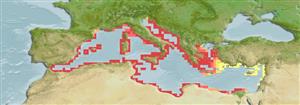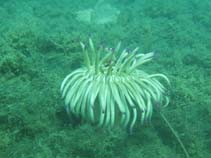Condylactis aurantiaca (Delle Chiaje, 1825)
Golden delicious anemone| Native range | All suitable habitat | Point map | Year 2050 |

|
| This map was computer-generated and has not yet been reviewed. |
| Condylactis aurantiaca AquaMaps Data sources: GBIF OBIS |
Classification / Names Common names | Synonyms | CoL | ITIS | WoRMS
Anthozoa | Actiniaria | Actiniidae
Environment: milieu / climate zone / depth range / distribution range Ecology
Sessile; depth range 1 - 10 m (Ref. 363). Subtropical
Distribution Countries | FAO areas | Ecosystems | Occurrences | Introductions
Endemic to the Mediterranean.
Length at first maturity / Size / Weight / Age
Maturity: Lm ? range ? - ? cm Max length : 12.0 cm WD male/unsexed; (Ref. 358)
Short description Morphology
Diameter of the pedal disc: 7 cm; diameter of the oral disc, without the tentacles: 12 cm maximum; 30 cm with its tentacles 96; laid out in 5 crowns around the oral siphon; and measuring approximately 8 cm; thick, they are completed in a round point. Oral disc comprising of the reasons for varied color: gray with nuances white; yellow; green or brown; also gray tentacles with nuances of white; yellow or brown; and with point violet; one the lower third of the foot; as for him, is red orange and counts 12 longitudinal bands of a tinted dirty white of yellow; partially discontinuous (Ref. 358).
Always inserted in the sandy or gravelly funds; the free foot in its substrate and the oral disc as well as the tentacles flat on the surface. Common of the small funds (Ref. 358). Sandy Funds from 1 to 10 m (Ref. 363). Known from infralittoral zones (Ref. 85338). Solitary (Ref. 2377).
Life cycle and mating behavior Maturity | Reproduction | Spawning | Eggs | Fecundity | Larvae
Members of the class Anthozoa are either gonochoric or hermaphroditic. Mature gametes are shed into the coelenteron and spawned through the mouth. Life cycle: The zygote develops into a planktonic planula larva. Metamorphosis begins with early morphogenesis of tentacles, septa and pharynx before larval settlement on the aboral end.
Main reference
References | Coordinator | Collaborators
Göthel, H. 1992. (Ref. 358)
IUCN Red List Status (Ref. 130435)
Least Concern (LC) ; Date assessed: 30 September 2014
CITES status (Ref. 108899)
Not Evaluated
CMS (Ref. 116361)
Not Evaluated
Threat to humans
Human uses
| FishSource |
Tools
More information
Internet sources
BHL | BOLD Systems | CISTI | DiscoverLife | FAO(Publication : search) | Fishipedia | GenBank (genome, nucleotide) | GloBI | Gomexsi | Google Books | Google Scholar | Google | PubMed | Hexacorallians of the World | Tree of Life | Wikipedia (Go, Search) | Zoological Record
Estimates based on models
Preferred temperature
(Ref. 115969): 17.6 - 21.8, mean 19.2 (based on 431 cells).
Price category
(Ref. 80766):
Unknown.



